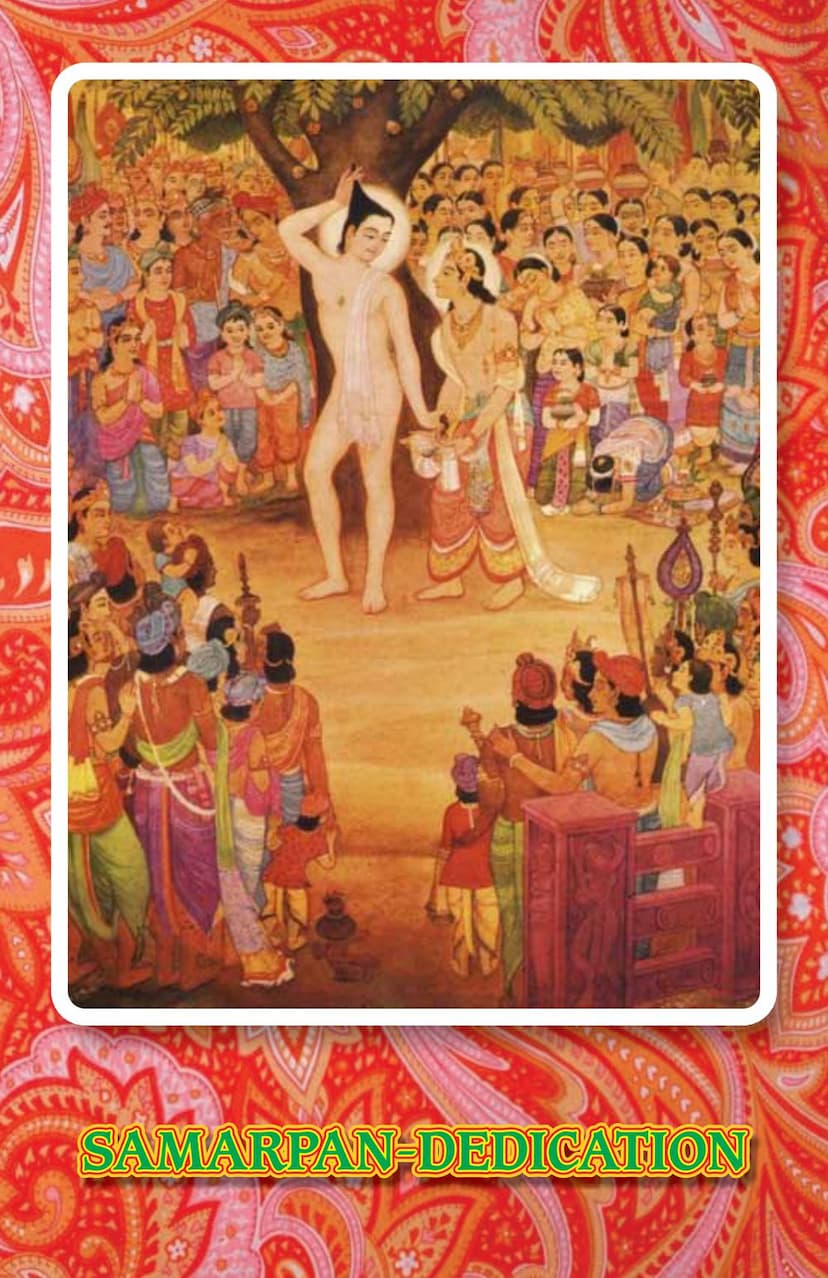Samarpan Dedication Badi Diksha Of Sadhvi Sanghmitraji
Added to library: September 2, 2025

Summary
This document, titled "SAMARPAN - DEDICATION: Badi Diksha of Sadhvi Sanghamitraji," chronicles the significant Jain spiritual event of the "Badi Diksha" (Great Initiation) of Sadhvi Sanghamitraji. The book is compiled by the JAINA Education Committee and published by Veerayatan.
Here's a comprehensive summary of its content:
1. Core Event and Purpose: The book centers around the "Badi Diksha" of Sadhvi Sanghamitraji, which took place on April 6-8, 2012, at the Jain Center of Northern California. This event is presented as a significant milestone, marking the first such ceremony in the USA and North America. The underlying theme is "Samarpan" or "Dedication," signifying a complete surrender to the spiritual path.
2. Key Figures:
- Sadhvi Sanghamitraji (Mangalam): The central figure of the book, whose "Badi Diksha" is being celebrated. The text details her background, her deep spiritual inclination from childhood, her studies under esteemed gurus, her life in the US with a family, and her ultimate calling to a spiritual life. She is described as having attained enlightened vision and embraced detachment.
- Acharya Shri Chandanaji Maharaj: The spiritual guide and mentor who performs the Badi Diksha. She is portrayed as the "prana" (life force) of Veerayatan, a charismatic and compassionate leader who instills life-transforming values and offers solutions to contemporary life challenges. Her vision of creating a "Divine World" in Palitana is also highlighted.
- Param Pujya Gurudev Upadhyay Shri Amar Muniji Maharaj: Mentioned as the Guru under whose grace Sadhvi Sanghamitraji received her classical studies.
3. Understanding Diksha: The book elaborates on the meaning of "Diksha" within Jainism, distinguishing between "Choti Diksha" (Initial Diksha) and "Badi Diksha" (Great Diksha).
- Choti Diksha: Described as the initial renunciation, accepting the Guru's call to experience inner truth.
- Badi Diksha: Explained as the final renunciation, where the aspirant, after a period of introspection and living the path (typically 4-6 months after initial diksha), fully accepts the awakening. It is a firm decision and acceptance of the Guru's command to follow the path of knowledge, devotion, and spiritual practices with commitment. It's about dedicating one's life to the glory of Jainism.
4. Veerayatan and its Mission: Veerayatan is presented as a non-governmental, non-sectarian organization dedicated to "Seva" (Humanitarianism), "Shiksha" (Education), and "Sadhna" (Inner development/Spirituality). It is highlighted as a beacon of hope for the needy and downtrodden, aiming to create a new world through the divine message of the Tirthankaras. The text mentions Veerayatan's presence in Rajgir (Bihar), Palitana (Gujarat), and its international presence.
5. Spiritual Texts and Teachings: A significant portion of the book is dedicated to presenting and summarizing important Jain scriptures and prayers:
- Gratitude Verse: A Sanskrit verse from Yogashastra expressing gratitude to the Guru for dispelling ignorance.
- Namaskāra Mahamangal Sutra: The core Jain mantra, highlighting its power to destroy sins and its auspiciousness.
- Chattari Mangalam Sutra: A prayer acknowledging the Arihantas, Siddhas, Ascetics, and the religion expounded by the Tirthankaras as auspicious and taking refuge in them.
- Shri Nandi-Suttam: Presented as a prayer for blessings and success, emphasizing the importance of the Lord, Guru, Sangha, and True Knowledge. The "Virastuti" (Praise of Lord Mahavir) and "Sangh Stuti" (Praise of the Jain Order) are included within this section.
- Shri Dasavaikalika-Suttam: The book provides summaries and verses from four chapters of this significant Jain text:
- Chapter 1 (Padhamam Ajjhayanang - Dumapupphiyā): Focuses on Ahimsa (non-violence) as the supreme religion, comparing the ascetic's life to a bee that takes nectar without harming the flower.
- Chapter 2 (Biam Ajjhayanang - Samannapuvvayam): Discusses the importance of renouncing desires and worldly attachments to achieve happiness and become a true renunciate.
- Chapter 3 (Taiyam Ajjhayanang - Khuddiyāyārakahā): Emphasizes the ascetic's need to live as a gentle, fragrant breeze, causing no burden to lay people, and cultivating simplicity and guilelessness.
- Chapter 4 (Cauttham Ajjhayanang - Chajjīvaniyā): Highlights the concept of "Awareness" (Viveka) in all actions as a means to avoid karmic bondage and attain liberation, stressing "first knowledge, then compassion."
- Reflections: The book includes reflections on various spiritual concepts:
- True Teacher (Sadguru): Defining the qualities of a true guru and expressing reverence.
- Universal Forgiveness: Echoing the sentiment of forgiving all beings.
- Universal Peace: Wishing well-being for all of existence.
- Universal Friendship: Expressing a desire for amity with all beings.
- Spirituality and Pure Consciousness: Describing the virtues like compassion, peace, equanimity, forgiveness, truth, renunciation, and detachment as essential for spiritual seekers. It also emphasizes the control of passions (anger, ego, deceit, greed) as the path to liberation.
6. Event Schedule and Details: The book provides a detailed schedule of the Badi Diksha ceremony and associated events, including Garba Raas, Ayambil oli Parna, cultural programs, religious sermons, a procession (Diksha Vargodo), and a public lunch.
7. Overall Message: "Samarpan - Dedication" is a tribute to Sadhvi Sanghamitraji's commitment to the Jain spiritual path. It serves as an educational resource on Jain principles, the significance of Diksha, and the role of spiritual leaders and organizations like Veerayatan. The book aims to inspire readers with the teachings of the Tirthankaras and the path of renunciation and self-realization. It also emphasizes the need for spiritual understanding in addressing the challenges of the modern world.